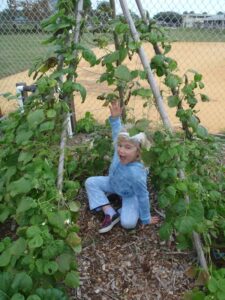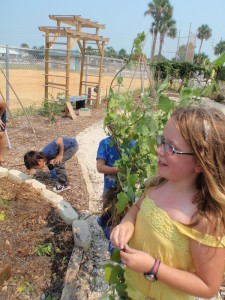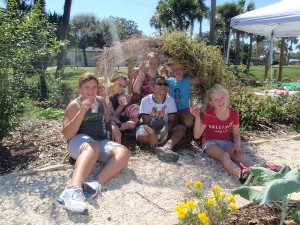Wonder Wednesday #5: Give Peas a Chance
Cool weather is the perfect time to plant peas. I think peas are a great thing to plant with children because they can be grown in fun ways and the children love to eat them raw right off the plant. Where you live will depend on when you actually plant your peas, but it is never too early to start planning. I hope you enjoy this lesson!
Kids love to get inside pea teepees. (Depending on the season, we grown peas or beans on these. Technically its beans in this pic.)
Give Peas a Chance!
Supplies:
Nature journals, rulers, pencils and/or crayons
Book: First Peas to the Table: How Thomas Jefferson Inspired a School Garden by Susan Grigsby
Pea seeds to plant in the garden. You may want to choose a variety of types
Optional: Fresh pea pods to taste after the story
Small pea teepees in a 4×8 garden bed.
Procedure:
Begin by asking the children some questions about peas and engage a short discussion: Do they like them, what color are they, have they tried them before, how do they grow – on a vine, bush, or stalk, inside a pod or from a flower, or both? This discussion will of course be modified for the various age groups as necessary. Remember flexibility within structure. Go with your instincts and follow the child’s curiosity!

Show them the book and read the story .
Explain that, like the characters in the book, they will plant pea seeds and observe how they grow documenting their observations in their nature journals.
Pass a seed to each child and have the child use the magnifying glass to closely observe the qualities of the seed and then draw the seed in the journal. Depending on the child they may want to also write “pea seed” on the page.
Once the child has documented their seed, they may plant it in the garden or designated space for the peas. Show them how to make a little hole with their finger, drop the seed in, and cover it back up, then water.
A shade trellis, with a bench for relaxing, is ready for planting is shown in the background here.
Explain that it is important to give the seeds something to climb reminding them of the previous conversation of how a pea is a vine. Then describe the ways you have decided to trellis the peas whether tunnels or teepees, on a fence or up a traditional trellis.
Kids like to get under and go through the tunnels.
Have the children water the seeds daily and once they sprout, begin to document the pea plant regularly.
**If there is a possibility of a freeze, the peas may need to be covered at night.
Making holes for seeds.
Extension Activities:
Review the story First Peas to the Table and have them describe the “contest” to you. Keep pea seeds watered and watch for sprouts. Count the number of sprouts, if any and measure them. Document this information in the nature journals. Now it is a race to see which plant gets tallest and which one will bring “peas to the table” first, just like in the story!
Have the students sketch and then build the trellis’ for the peas incorporating a geometry lesson on topics such as cones, arcs, and lines (convergent, divergent, parallel)
Have the students research Thomas Jefferson and his historic agricultural accomplishments and how pea seeds are still being saved at Monticello today. This is a great lesson to do in February for Presidents Day.
See the teepees in the back of this Monticello vegetable garden.
(Photo from MonticelloClassroom.org)
Seeds to Sprout:
Order heirloom and unique variety peas from Southern Exposure or Seed Savers
Learn more about Monticello’s gardens here.
A Rich spot of Earth: Thomas Jefferson’s Revolutionary Garden at Monticello A book all about the gardens.
NY Times article on the modern validity of Jefferson’s Gardening methods.
Find more lessons and curriculums and even online activities for children at Monticello Classroom.








Comments are closed.